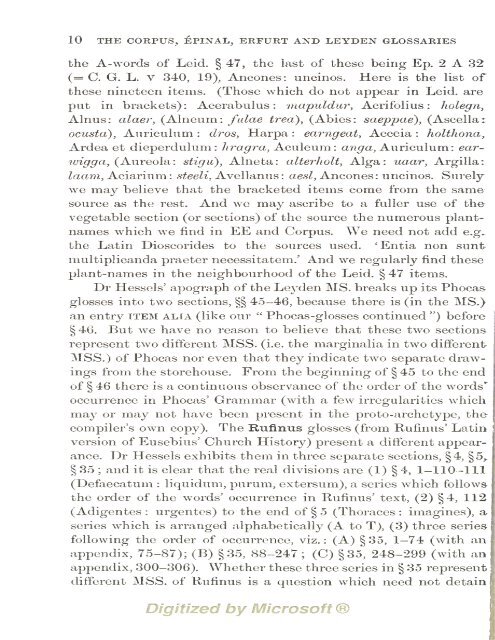the corpus, épinal, erfurt and leyden glossaries, viii - World eBook ...
the corpus, épinal, erfurt and leyden glossaries, viii - World eBook ...
the corpus, épinal, erfurt and leyden glossaries, viii - World eBook ...
You also want an ePaper? Increase the reach of your titles
YUMPU automatically turns print PDFs into web optimized ePapers that Google loves.
10 THE CORPUS, EPINAL, ERFURT AND LEYDEN GLOSSARIES<br />
<strong>the</strong> A-words of Leid. § 47, <strong>the</strong> last of <strong>the</strong>se being Ep. 2 A 32<br />
(= C. G. L. V 340, 19), Ancones: uncinos. Here is <strong>the</strong> list of<br />
<strong>the</strong>se nineteen items. (Those which do not appear in Leid. are<br />
put in brackets): Acerabulus: mapuldur, Acrifolius: holegn,<br />
Alnus : : alaer, (Alneum fulae trea), (Abies : saeppae), (Ascella :<br />
ociista), Auriculum :<br />
dros, Harpa: earngeat, Acceia : holthona,<br />
Ardea et dieperdulum: hragra, Aculeum: an^a, Auriculum: eaj^-<br />
wigga, (Aureola :<br />
laam, Aciarium : steeli, Avellanus :<br />
stigu), Alneta : alterholt, Alga : uaar, Argilla :<br />
aesl, Ancones: uncinos. Surely<br />
we may believe that <strong>the</strong> bracketed items come from <strong>the</strong> same<br />
source as <strong>the</strong> rest. And we may<br />
ascribe to a fuller use of <strong>the</strong><br />
vegetable sectioii (or sections) of <strong>the</strong> source <strong>the</strong> numerous plantnames<br />
which we find in EE <strong>and</strong> Corpus. We need not add e.g.<br />
<strong>the</strong> Latin Dioscorides to <strong>the</strong> sources used. 'Entia non sunt-<br />
multiplic<strong>and</strong>a praeter necessitatem.' And we regularly find <strong>the</strong>se<br />
47 items.<br />
plant-names in <strong>the</strong> neighbourhood of <strong>the</strong> Leid. §<br />
Dr Hessels' apograph of <strong>the</strong> Leyden MS. breaks up its Phoca&<br />
glosses into two sections, §§ 45-46, because <strong>the</strong>re is (in <strong>the</strong> MS.)<br />
an entry item alia (like our "<br />
Phocas-glosses continued ") before<br />
§ 46. But we have no reason to believe that <strong>the</strong>se two sections<br />
represent two different MSS. (i.e. <strong>the</strong> marginalia in two different-<br />
MSS.) of Phocas nor even that <strong>the</strong>y indicate two separate drawings<br />
from <strong>the</strong> storehouse. From <strong>the</strong> beginning of § 45 to <strong>the</strong> end<br />
of § 46 <strong>the</strong>re is a continuous observance of <strong>the</strong> order of <strong>the</strong> words''<br />
occurrence in Phocas' Grammar (with a few irregularities which<br />
may or may not have been present in <strong>the</strong> proto-archetype, <strong>the</strong><br />
compiler's own copy). The Rufinus glosses (from Rufinus' Latin<br />
version of Eusebius' Church History) present a different appear-<br />
ance. Dr Hessels exhibits <strong>the</strong>m in three separate sections, §4, §5^<br />
§ 35 ; <strong>and</strong> it is clear that <strong>the</strong> real divisions are (1) § 4, 1-110-111<br />
(Defaecatum : liquidum, purum, extersum), a series which follows ^<br />
<strong>the</strong> order of <strong>the</strong> words' occurrence in Rufinus' text, (2) §4, 112<br />
(Adigentes :<br />
urgentes)<br />
to <strong>the</strong> end of §5 (Thoraces: imagines), a<br />
series which is arranged alphabetically (A to T), (3) three series<br />
following <strong>the</strong> order of occurrence, viz.: (A) §35, 1-74 (with an<br />
appendix, 75-87); (B) §35, 88-247 ; (C) §35, 248-299 (with an<br />
appendix, 300-306). Whe<strong>the</strong>r <strong>the</strong>se three series in § 35 represent<br />
different MSS. of Rufinus is a question which need not detain<br />
|

















